Njengamartin399
On this page, you find all documents, package deals, and flashcards offered by seller njengamartin399.
- 141
- 0
- 7
Community
- Followers
- Following
148 items

Congestive Heart Failure, Pulmonary Edema, and Hypertensive Crisis
A nurse is caring for a patient with left-sided heart failure. Which clinical manifestation is the nurse most likely to observe? A. Jugular vein distention B. Dependent edema C. Crackles in the lungs D. Hepatomegaly Correct Answer: C. Crackles in the lungs Rationale: Crackles in the lungs are indicative of left-sided heart failure due to fluid backing up into the lungs. Jugular vein distention, dependent edema, and hepatomegaly are more common in right-sided heart failure. NCLEX Preferen...
- Exam (elaborations)
- • 29 pages •
A nurse is caring for a patient with left-sided heart failure. Which clinical manifestation is the nurse most likely to observe? A. Jugular vein distention B. Dependent edema C. Crackles in the lungs D. Hepatomegaly Correct Answer: C. Crackles in the lungs Rationale: Crackles in the lungs are indicative of left-sided heart failure due to fluid backing up into the lungs. Jugular vein distention, dependent edema, and hepatomegaly are more common in right-sided heart failure. NCLEX Preferen...
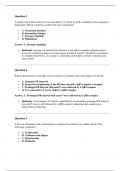
Conduction Blocks
Question 1 A patient with a known history of second-degree AV block Type II is admitted to the emergency department. Which symptom would be the most concerning? • A. Occasional dizziness • B. Intermittent fatigue • C. Syncope (fainting) • D. Palpitations Answer: C. Syncope (fainting) • Rationale: Syncope can indicate that the heart is not able to maintain adequate output due to the conduction delay in second-degree AV block Type II. This block can progress to complete heart bloc...
- Exam (elaborations)
- • 23 pages •
Question 1 A patient with a known history of second-degree AV block Type II is admitted to the emergency department. Which symptom would be the most concerning? • A. Occasional dizziness • B. Intermittent fatigue • C. Syncope (fainting) • D. Palpitations Answer: C. Syncope (fainting) • Rationale: Syncope can indicate that the heart is not able to maintain adequate output due to the conduction delay in second-degree AV block Type II. This block can progress to complete heart bloc...
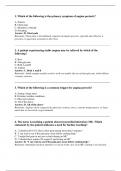
Acute Coronary Syndrome (Angina Pectoris and Myocardial Infarction)
1. Which of the following is the primary symptom of angina pectoris? A. Nausea B. Chest pain C. Shortness of breath D. Sweating Answer: B. Chest pain Rationale: Chest pain is the hallmark symptom of angina pectoris, typically described as a pressure or squeezing sensation in the chest. ________________________________________ 2. A patient experiencing stable angina may be relieved by which of the following? A. Rest B. Nitroglycerin C. Both A and B D. Aspirin Answer: C. Both A and B ...
- Exam (elaborations)
- • 17 pages •
1. Which of the following is the primary symptom of angina pectoris? A. Nausea B. Chest pain C. Shortness of breath D. Sweating Answer: B. Chest pain Rationale: Chest pain is the hallmark symptom of angina pectoris, typically described as a pressure or squeezing sensation in the chest. ________________________________________ 2. A patient experiencing stable angina may be relieved by which of the following? A. Rest B. Nitroglycerin C. Both A and B D. Aspirin Answer: C. Both A and B ...

Hemodynamic Monitoring
1. What does central venous pressure (CVP) monitoring primarily assess? A. Cardiac output B. Left ventricular function C. Right atrial pressure D. Systemic vascular resistance Answer: C. Right atrial pressure Rationale: CVP monitoring provides an estimate of right atrial pressure and reflects the volume status and function of the right side of the heart. ________________________________________ 2. Which of the following is a complication associated with pulmonary artery catheter placemen...
- Exam (elaborations)
- • 18 pages •
1. What does central venous pressure (CVP) monitoring primarily assess? A. Cardiac output B. Left ventricular function C. Right atrial pressure D. Systemic vascular resistance Answer: C. Right atrial pressure Rationale: CVP monitoring provides an estimate of right atrial pressure and reflects the volume status and function of the right side of the heart. ________________________________________ 2. Which of the following is a complication associated with pulmonary artery catheter placemen...
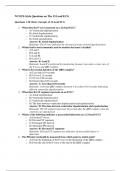
The 12-Lead ECG
Questions 1-10: Basic Concepts of 12-Lead ECG 1. What does the P wave represent on a 12-lead ECG? o A) Ventricular depolarization o B) Atrial depolarization o C) Ventricular repolarization o D) Atrial repolarization Answer: B) Atrial depolarization Rationale: The P wave indicates the electrical activity of atrial depolarization. 2. Which lead is most commonly used to monitor the heart's rhythm? o A) Lead I o B) Lead II o C) Lead III o D) Lead V1 Answer: B) Lead II Rationale: Lea...
- Exam (elaborations)
- • 12 pages •
Questions 1-10: Basic Concepts of 12-Lead ECG 1. What does the P wave represent on a 12-lead ECG? o A) Ventricular depolarization o B) Atrial depolarization o C) Ventricular repolarization o D) Atrial repolarization Answer: B) Atrial depolarization Rationale: The P wave indicates the electrical activity of atrial depolarization. 2. Which lead is most commonly used to monitor the heart's rhythm? o A) Lead I o B) Lead II o C) Lead III o D) Lead V1 Answer: B) Lead II Rationale: Lea...

The Normal ECG
Question 1 What does the P wave represent in a normal ECG? • A) Ventricular depolarization • B) Atrial depolarization • C) Ventricular repolarization • D) Atrial repolarization Answer: B) Atrial depolarization Rationale: The P wave reflects the electrical activity associated with atrial depolarization. ________________________________________ Question 2 Which interval on the ECG indicates the time it takes for electrical conduction from the atria to the ventricles? • A) PR i...
- Exam (elaborations)
- • 19 pages •
Question 1 What does the P wave represent in a normal ECG? • A) Ventricular depolarization • B) Atrial depolarization • C) Ventricular repolarization • D) Atrial repolarization Answer: B) Atrial depolarization Rationale: The P wave reflects the electrical activity associated with atrial depolarization. ________________________________________ Question 2 Which interval on the ECG indicates the time it takes for electrical conduction from the atria to the ventricles? • A) PR i...
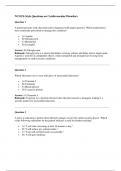
Diagnosis and Treatment of Cardiovascular Disorders
A patient presents with chest pain and is diagnosed with angina pectoris. Which medication is most commonly prescribed to manage this condition? • A) Aspirin • B) Nitroglycerin • C) Metoprolol • D) Lisinopril Answer: B) Nitroglycerin Rationale: Nitroglycerin is a nitrate that dilates coronary arteries and helps relieve angina pain. Aspirin is used for its antiplatelet effects, while metoprolol and lisinopril are for long-term management of cardiovascular conditions. ______________...
- Exam (elaborations)
- • 21 pages •
A patient presents with chest pain and is diagnosed with angina pectoris. Which medication is most commonly prescribed to manage this condition? • A) Aspirin • B) Nitroglycerin • C) Metoprolol • D) Lisinopril Answer: B) Nitroglycerin Rationale: Nitroglycerin is a nitrate that dilates coronary arteries and helps relieve angina pain. Aspirin is used for its antiplatelet effects, while metoprolol and lisinopril are for long-term management of cardiovascular conditions. ______________...
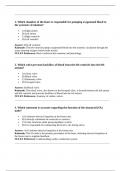
Cardiovascular Anatomy and Physiology in critical care nursing
1. Which chamber of the heart is responsible for pumping oxygenated blood to the systemic circulation? • A) Right atrium • B) Left atrium • C) Right ventricle • D) Left ventricle Answer: D) Left ventricle Rationale: The left ventricle pumps oxygenated blood into the systemic circulation through the aorta, ensuring oxygen reaches body tissues. NCLEX Preference: Basic cardiovascular anatomy and physiology. ________________________________________ 2. Which valve prevents backflow o...
- Exam (elaborations)
- • 20 pages •
1. Which chamber of the heart is responsible for pumping oxygenated blood to the systemic circulation? • A) Right atrium • B) Left atrium • C) Right ventricle • D) Left ventricle Answer: D) Left ventricle Rationale: The left ventricle pumps oxygenated blood into the systemic circulation through the aorta, ensuring oxygen reaches body tissues. NCLEX Preference: Basic cardiovascular anatomy and physiology. ________________________________________ 2. Which valve prevents backflow o...
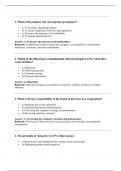
CPA Australia Ethics and governance
1. What is the primary role of corporate governance? • a) To maximize shareholder returns • b) To ensure compliance with laws and regulations • c) To protect the interests of all stakeholders • d) To manage operational risk Answer: c) To protect the interests of all stakeholders Rationale: Corporate governance ensures the company’s accountability to shareholders, employees, customers, and other stakeholders. ________________________________________ 2. Which of the following is ...
- Exam (elaborations)
- • 18 pages •
1. What is the primary role of corporate governance? • a) To maximize shareholder returns • b) To ensure compliance with laws and regulations • c) To protect the interests of all stakeholders • d) To manage operational risk Answer: c) To protect the interests of all stakeholders Rationale: Corporate governance ensures the company’s accountability to shareholders, employees, customers, and other stakeholders. ________________________________________ 2. Which of the following is ...
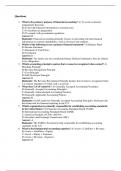
CPA 101
Questions on the following chapters,answers and rationales included Financial Accounting and Accounting Standards The Business of Accounting Ancient Accounting, Modern Accounting Accounting Rules Generally Accepted Accounting Principles Tracking and Measuring Success Bookkeeping Versus Accounting
- Package deal
- • 8 items •
- Financial Accounting and Accounting Standards • Exam (elaborations)
- The Business of Accounting • Exam (elaborations)
- Ancient Accounting • Exam (elaborations)
- Modern Accounting • Exam (elaborations)
- Accounting Rules • Exam (elaborations)
- And more ….
Questions on the following chapters,answers and rationales included Financial Accounting and Accounting Standards The Business of Accounting Ancient Accounting, Modern Accounting Accounting Rules Generally Accepted Accounting Principles Tracking and Measuring Success Bookkeeping Versus Accounting
